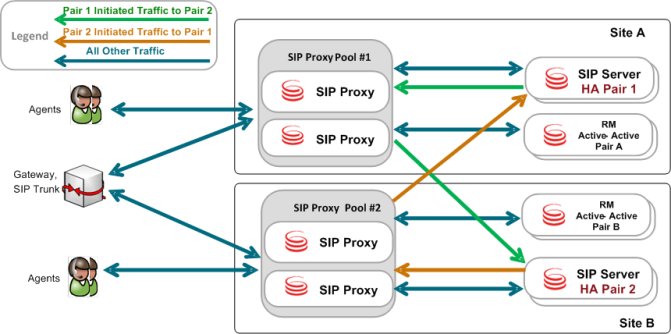Overview
The primary purpose of Genesys SIP Proxy is to provide high availability without requiring a virtual IP address.
There are five fundamental concepts:
- The purpose of SIP Proxy is to provide high availability for a primary/backup SIP Server HA pair without requiring a virtual IP address.
- A pool of SIP Proxy instances is defined for each SIP Server HA pair. Each SIP Proxy instance monitors all known SIP Server HA pairs to determine which SIP Server is currently active and which is backup. There is no communication between pool members. SIP is used for communication between SIP Server and SIP Proxy.
- Incoming SIP messages are proxied to the primary SIP Server instance. It is the responsibility of external SIP user agents to select a proxy instance based either on DNS or static configuration of multiple IP addresses, and to fall back to an alternate instance if the selected instance is not responding.
- The SIP Server HA pair is configured to use the SIP Proxy FQDN (resolved into a single or multiple SRV records) specified in the SIP Outbound Proxy DN of type Voice over IP Service.
- SIP Proxy functions as a proxy defined in RFC 3261 section 16.
Note: As of March 2013, SIP Proxy has been tested with Polycom SoundPoint IP phones. Additional endpoints are scheduled for testing.
Single-Site Deployment
In a standard deployment, a pool of SIP Proxy instances handles incoming and outgoing SIP transactions between a SIP Server HA pair and external SIP elements. Each SIP transaction is handled by a single SIP Proxy instance. Subsequent transactions may be handled by the same or different proxy instance(s). Each SIP Proxy monitors every SIP Server instance.
The workflow of a primary-to-backup switchover proceeds as follows:
- The primary SIP Server fails, disconnects, or a switchover is initiated manually.
- SIP Proxy detects the primary SIP Server failure (or disconnection) if one of the following occurs:
- The primary SIP Server stops responding to OPTIONS messages.
- SIP Proxy receives a SIP request from the backup SIP Server.
- SIP Proxy proxies all SIP traffic to the backup SIP Server which now runs in primary mode.
Note: Multiple independent Active-Active RM pairs may be deployed, although this configuration is not depicted here.
Requirement for third-party components
To successfully integrate any third-party component (SIP endpoints, gateways, softswitches) with SIP Proxy and SIP Server in a standalone deployment, the third-party component must be able to do both of the following:
- Resolve the SIP Proxy FQDN into multiple A-records
- Identify which SIP Proxy is active
Multi-Site or Business Continuity Deployment
In a multi-site or business continuity deployment, each SIP transaction is handled by a single SIP Proxy. For each site, one or more SIP Proxies must be configured to serve only that site by forwarding requests from endpoints or gateways to the IP address of the primary SIP Server in the HA pair. Each SIP Server HA pair requires a unique pool of SIP Proxy instances. SIP Servers use any SIP Proxy from its pool for inter-server or outgoing requests. Each SIP Proxy monitors every SIP Server instance.


